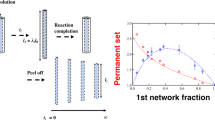Summary
Elasticity and light scattering measurements were carried out on poly(acrylamide) (PAAm) hydrogels prepared from acrylamide (AAm) and N,N’-methylenebisacrylamide (BAAm) monomers under various reaction conditions. Elasticity tests showed that the crosslinking efficiency of BAAm ε xl , that is the fraction of BAAm forming effective crosslinks decreases as the initial monomer concentration C o is decreased. At C o =3%, ε xl was found to be 10-2–10-3, indicating that 99 to 99.9% of BAAm used in the hydrogel preparation are wasted in elastically ineffective links. Debye-Bueche analysis of the light scattering data showed that, irrespective of the gel synthesis conditions, the correlation length ξ, that is, the extension of inhomogeneities in the hydrogels is 101 nm. The extent of frozen concentration fluctuations in the hydrogels represented by 〈η2〉 decreases with increasing crosslinking efficiency of BAAm. The combination of the light scattering and the elasticity data of gels shows a direct correlation between the fraction of wasted crosslinker molecules during gelation and the spatial gel inhomogeneity.
Similar content being viewed by others
References
Funke W, Okay O, Joos-Muller B (1998) Adv Polym Sci 136:139
Okay O (2000) Prog Polym Sci 25:711
Dusek K (1982) Network formation by chain crosslinking (co)polymerization. Developments in Polymerization-3. In: Haward RN, ed London: Applied Science, p 143
Shibayama M (1998) Macromol Chem Phys 199:1
Bastide J, Candau SJ (1996) Physical properties of polymeric gels. In: Cohen Addad JP, ed NY: Wiley, p 143
Mallam S, Horkay F, Hecht AM, Geissler E (1989) Macromolecules 22:3356
Ikkai F, Shibayama M (1997) Phys Rev E 56: R51
Schosseler F, Skouri R, Munch JP, Candau SJ (1994) J Phys II 4:1221
Kizilay MY, Okay O (2003) Macromolecules 36:6856
Lindemann B, Schröder UP, Oppermann W (1997) Macromolecules 30:4073
Kizilay MY, Okay O (2004) Polymer 45:2567
Sayıl C, Okay O (2001) Polymer 42:7639
Flory PJ (1953) Principles of Polymer Chemistry, Cornell University Press, Ithaca, NY
Treloar LRG (1975) The Physics of Rubber Elasticity, University Press, Oxford
Debye PJ (1959) J Chem Phys 31:680
Bueche F (1970) J Colloid Interface 33:61
Debye P, Bueche AM (1949) J Appl Phys 20:518
Kizilay MY, Okay O (2003) Polymer 44:5239
Author information
Authors and Affiliations
Corresponding author
Rights and permissions
About this article
Cite this article
Orakdogen, N., Okay, O. Correlation between crosslinking efficiency and spatial inhomogeneity in poly(acrylamide) hydrogels. Polym. Bull. 57, 631–641 (2006). https://doi.org/10.1007/s00289-006-0624-1
Received:
Revised:
Accepted:
Published:
Issue Date:
DOI: https://doi.org/10.1007/s00289-006-0624-1




